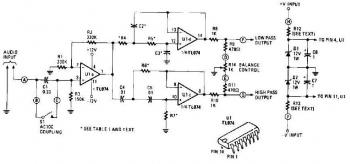This is the circuit diagram of active crossover. The crosover circuit built based TL047 and it should be placed before amplifier circuit module.
How it works..?
An audio source, like a mixer, preamp, EQ, or a recorder, is fed towards the input of the active crossover circuit. This signal is either AC or coupling, based on the setting of switch 51, the non-inverting input of buffer amplifier Ul-a, a section of a quad BIFET, low amp TL074 noise produced by Texas Instruments op. This stage has a gain of two, and its output is distributed to both a low pass filter created by R4, R5, C2, C3, and Uld op-amp, along with a high-pass filter created by R6, R7, C4 , C5, and op amp ULC. These are12 dB / octave Butterworth filters. The response of the Butterworth filter was chosen simply because it provides the most effective compromise between the damping and phase.
The values of capacitors and resistors varies based on the selected connection that your device works. The filter outputs are fed to a balancing network created by R8, R9, RIO, R14 and potentiometer RLL balance. When the potentiometer is at its center position, there is certainly a unity gain bandwidths for both high and low filters. The power supply for the electronic circuit is regulated by Crossover R12, RI3, Dl and D2, and decoupled by C6 and C7.
About Audio Amplifier
An audio amplifier is an electronic amplifier that amplifies low-power audio signals (signals composed primarily of frequencies between 20 - 20 000 Hz, the human range of hearing) to a level suitable for driving loudspeakers and is the final stage in a typical audio playback chain.
The preceding stages in such a chain are low power audio amplifiers which perform tasks like pre-amplification, equalization, tone control, mixing/effects, or audio sources like record players, CD players, and cassette players. Most audio amplifiers require these low-level inputs to adhere to line levels.
While the input signal to an audio amplifier may measure only a few hundred microwatts, its output may be tens, hundreds, or thousands of watts. More explanation about power audio amplifier can be found at wikipedia.org
An audio amplifier is an electronic amplifier that amplifies low-power audio signals (signals composed primarily of frequencies between 20 - 20 000 Hz, the human range of hearing) to a level suitable for driving loudspeakers and is the final stage in a typical audio playback chain.
The preceding stages in such a chain are low power audio amplifiers which perform tasks like pre-amplification, equalization, tone control, mixing/effects, or audio sources like record players, CD players, and cassette players. Most audio amplifiers require these low-level inputs to adhere to line levels.
While the input signal to an audio amplifier may measure only a few hundred microwatts, its output may be tens, hundreds, or thousands of watts. More explanation about power audio amplifier can be found at wikipedia.org
This is a video tutorial about how to a very simple audio amplifier based on the LM386 amplifier chip. It can be built for less than $20 (or might be less than $8 in some countries) and used to amplify any low level audio signal including a guitar, bass or mp3 player.
Watch the video:

No comments:
Post a Comment